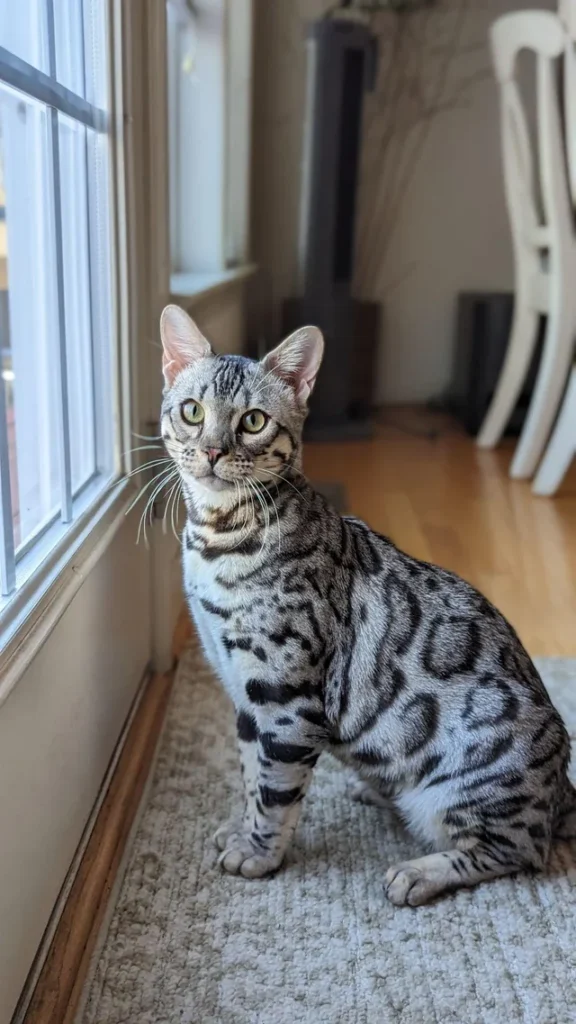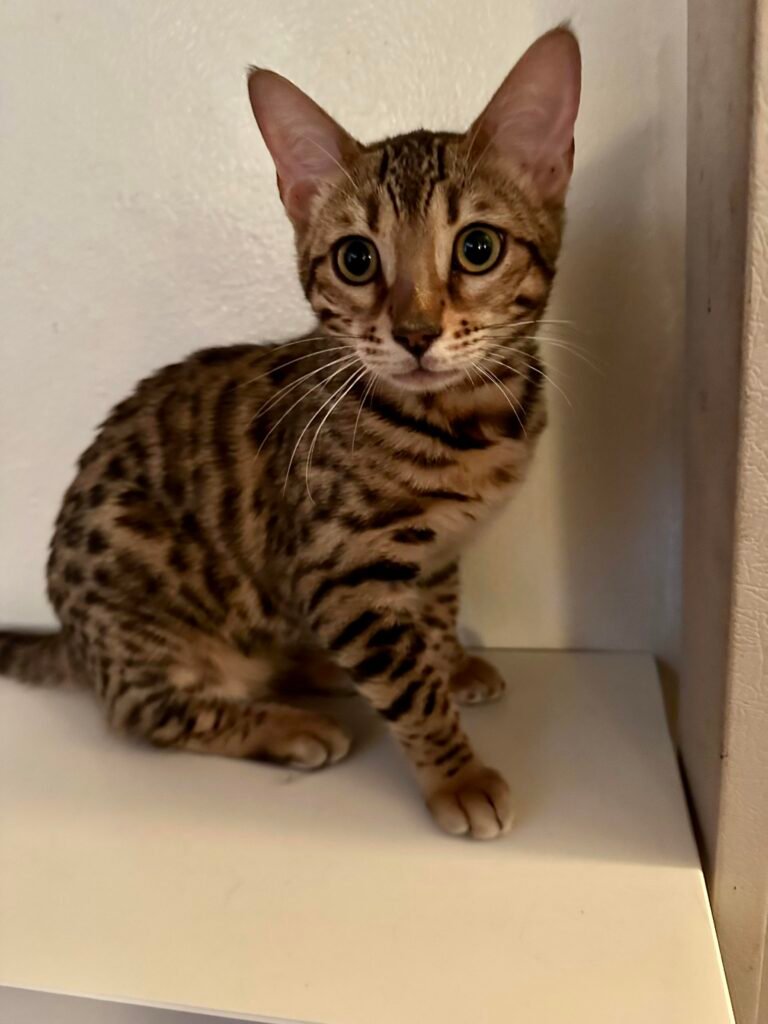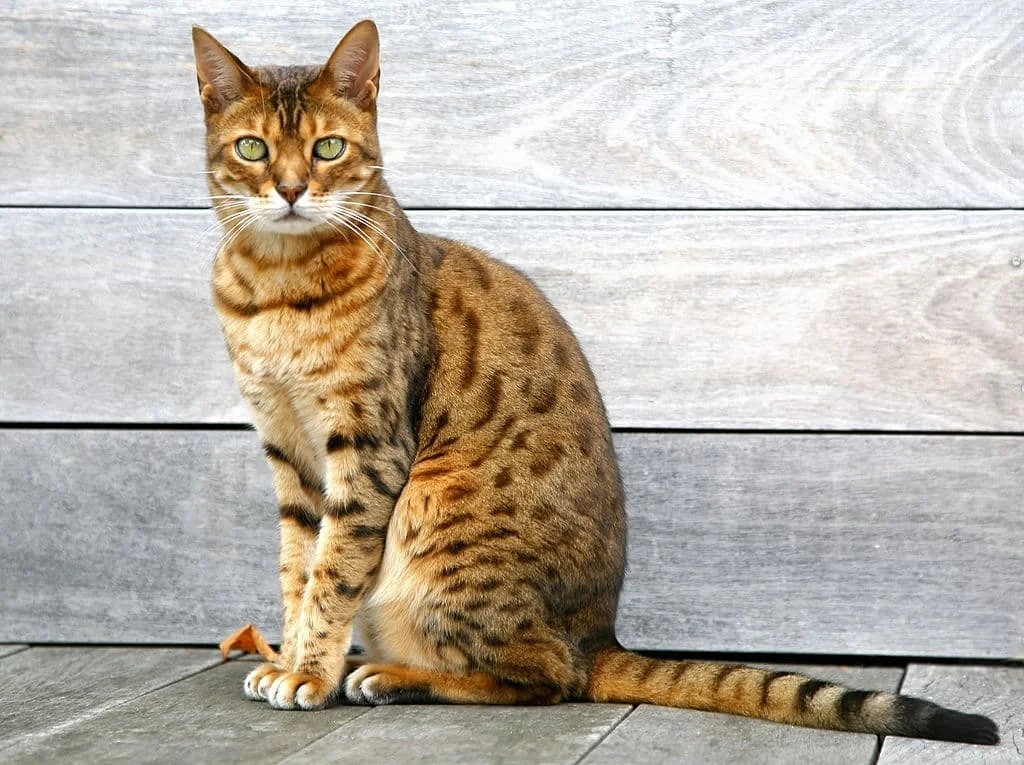Bengal
The Bengal cat is a breed that captivates with its distinctive physical features, setting it apart from other domesticated felines. One of the most striking attributes of the Bengal cat is its coat, which is reminiscent of a wild leopard. This luxurious fur is typically adorned with bold markings, such as rosettes or marbling, presenting an appearance often associated with exotic wildlife. The variety of coat colors, including brown, silver, and snow variations, contributes to their visual allure, making Bengals an attractive choice for cat enthusiasts.

In addition to their remarkable coat, Bengal cats possess a robust and muscular build. Their physique is characterized by a long, sleek body that is both athletic and agile. This muscularity not only enhances their striking appearance but also provides a degree of strength that allows them to be active and playful. One might often find Bengals engaging in lively activities, such as climbing and jumping, given their energetic nature. Adult Bengals typically weigh between 8 to 15 pounds, with males generally larger than females. This size range complements their athletic build, ensuring they maintain a graceful, yet powerful presence.
The Bengal’s expressive eyes further enhance its captivating appearance. These felines often feature large, almond-shaped eyes that can come in shades of green, gold, or blue, making them even more eye-catching. The vivid color of their eyes beautifully contrasts with their intricate coat patterns, adding to their overall charm. Furthermore, Bengals possess a thick tail that is of medium length, reflecting their dynamic nature and ability to balance while playing or climbing. Collectively, these physical traits not only underline the Bengal cat’s exotic appeal but also contribute significantly to its popularity as a cherished pet among cat lovers.

Personality
The Bengal cat is renowned for its dynamic personality, capturing the hearts of many cat enthusiasts. One of the most striking traits of the Bengal is their energetic nature. Unlike more sedentary cat breeds, Bengals are highly active and require ample stimulation to keep them engaged. This energy manifests in a love for climbing, playing, and exploring their environment. As such, providing vertical spaces and interactive toys is essential for their well-being.
Playfulness is another prominent trait of the Bengal cat. These felines are known for their love of games and antics, often participating in activities that stimulate their agile bodies and keen minds. They thrive on interactive play, and engaging with toys that mimic prey, such as feather wands or laser pointers, can bring out their natural hunting instincts. Bengals frequently make their playtime a social event, often inviting their human companions to join in on the fun.
Social behavior is also a cornerstone of the Bengal’s personality. They are affectionate and exhibit a strong desire to be near their owners, often following them from room to room. Additionally, they generally get along well with other pets, making them suitable companions in multi-pet households. Their intelligence is another defining characteristic; Bengals are quick learners who enjoy mastering new tricks and games. Owners can benefit from scheduled training sessions that incorporate positive reinforcement techniques.
Furthermore, Bengal cats exhibit a loving temperament that stands out among feline breeds. They seek companionship, demonstrating their need for social interaction through cuddling and vocal communication. Potential owners should be prepared to invest time in nurturing their Bengal’s social needs, ensuring they remain active and mentally stimulated. Fulfilling these requirements not only enhances the cat’s quality of life but also fosters a deep, lasting bond between the Bengal and their human companions.
Origins
The Bengal cat has a captivating lineage that traces back to its ancestors, the Asian leopard cat (Prionailurus bengalensis). This wild cat, native to Asia, features a striking spotted or marbled coat that has significantly influenced the appearance of the Bengal breed we know today. The relationship between the leopard cat and domestic cats initially sparked interest among breeders in the 1960s, which set the stage for the development of the Bengal cat as a breed.

One of the key figures in this development was Jean Sugden Mill, an American breeder who played a pivotal role in the creation of the Bengal cat in the 1980s. Mill crossbred the Asian leopard cat with domestic breeds, namely the Abyssinian, Burmese, and Egyptian Mau, aiming to combine the exotic appearance of the wild leopard cat with the temperament of a domesticated feline. This deliberate breeding led to offspring that exhibited the desired aesthetic traits while being suitable as loving companions.
The Bengal cat’s unique coat pattern and vibrant personality quickly garnered attention. In 1986, the International Cat Association (TICA) accepted the Bengal cat for registration, significantly enhancing its status among cat fancier communities. Following this recognition, the breed’s popularity surged, leading to its acknowledgment by various other cat registries in subsequent years. The Bengal cat’s distinct appearance combined with an active and intelligent nature has made it a favored choice among cat enthusiasts.
As we explore the Bengal’s historical journey, it is evident that the blend of the wild and domestic elements has crafted a breed that is not only visually stunning but also possesses a distinct character. This fascinating background has solidified the Bengal cat’s place in both the feline world and among pet owners around the globe.
Care of the Bengal cat
As an owner of a Bengal cat, understanding their unique care and maintenance requirements is essential for preserving their health and ensuring their overall well-being. One of the primary aspects of caring for a Bengal cat is addressing their dietary needs. Bengal cats are known for their energetic personalities and active lifestyles, necessitating a high-protein diet that supports muscle development and energy levels. It is advisable to provide high-quality commercial cat food formulated for active breeds, and incorporating wet food can also help maintain hydration.
Grooming is another critical component of a Bengal’s care. Despite their short coat, Bengal cats benefit from regular grooming sessions that help reduce shedding and distribute natural oils throughout their fur. A weekly brush can suffice, but during shedding seasons, more frequent grooming may be required. Regular grooming not only keeps their coat healthy but also serves as an opportunity for bonding between the owner and the pet.
Due to their high energy levels, it is crucial to provide ample opportunities for physical activity. Engaging playtime activities such as interactive toys, feather wands, and laser pointers can effectively stimulate a Bengal cat’s mind and body. Additionally, setting up an environment that encourages climbing and exploration, including cat trees and shelves, can satisfy their natural curiosity and playful instincts.
Regular veterinary care is paramount in ensuring a Bengal cat’s health. Routine check-ups can help catch any early signs of potential health issues, such as hip dysplasia or heart problems, that may be more prevalent in this breed. Vaccinations, flea control, and dental care should also be prioritized to keep your Bengal cat healthy.
In conclusion, caring for a Bengal cat requires dedication and a deeper understanding of their specific needs, including diet, grooming, exercise, and health considerations. By providing comprehensive care, owners can enjoy the vibrant and affectionate nature of this remarkable breed.
Health
Bengal cats are generally healthy, but they can be prone to genetic conditions like hypertrophic cardiomyopathy (HCM) and progressive retinal atrophy (PRA). A balanced diet, regular vet check-ups, and an active lifestyle help maintain their well-being. Proper grooming and dental care also prevent common health issues. Learn how to keep your Bengal cat thriving!
Nutrition
The Bengal cat thrives on a high-protein, meat-based diet rich in essential nutrients. As an active and muscular breed, Bengals benefit from quality wet food or a raw diet to support their energy levels, digestion, and coat health. Avoid fillers like grains and opt for high-protein, grain-free options to keep your Bengal strong and healthy.
Cleanliness
Bengal cats are naturally clean, with short, sleek coats that require minimal grooming. Their fine fur sheds less than other breeds, reducing allergens and mess. Known for their fastidious self-cleaning habits, Bengals rarely need baths. Regular brushing and occasional nail trimming keep them in top condition. Their cleanliness, combined with a love for water, makes them a low-maintenance yet hygienic feline companion.
Best cat breeds for kids
The Bengal cat is a playful, intelligent, and affectionate breed, making it a great choice for families with kids. Known for its stunning leopard-like coat, high energy, and love for interactive play, the Bengal thrives in active households. This friendly and social breed enjoys bonding with children, making it one of the best cat breeds for families.
People who have seen this breed have also visited…
In this section you can find completely detailed information about the breed of your cat.
